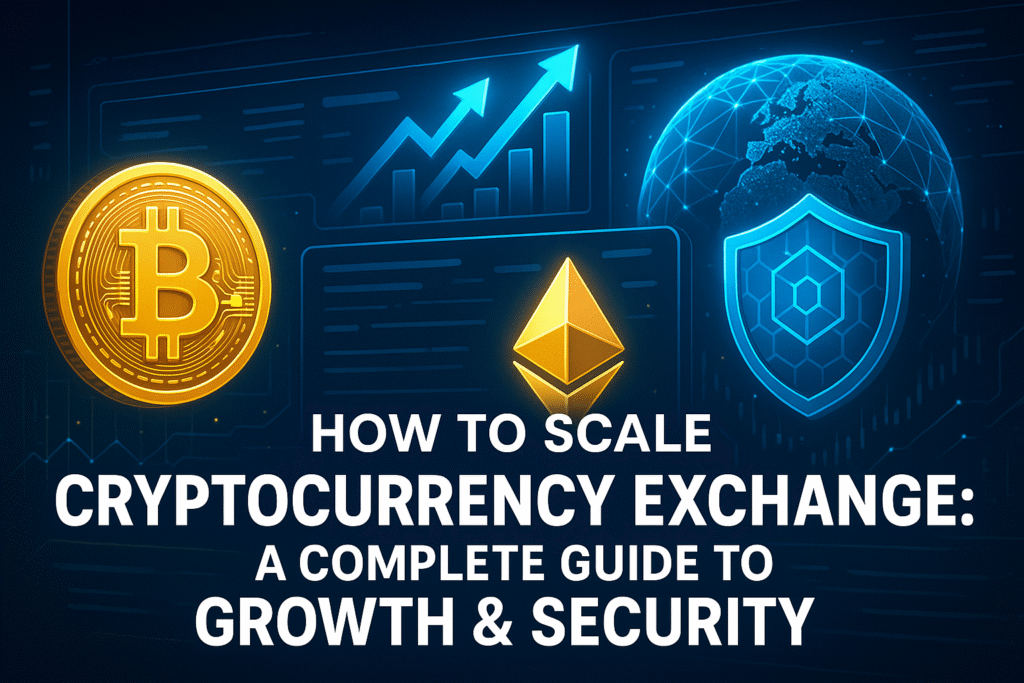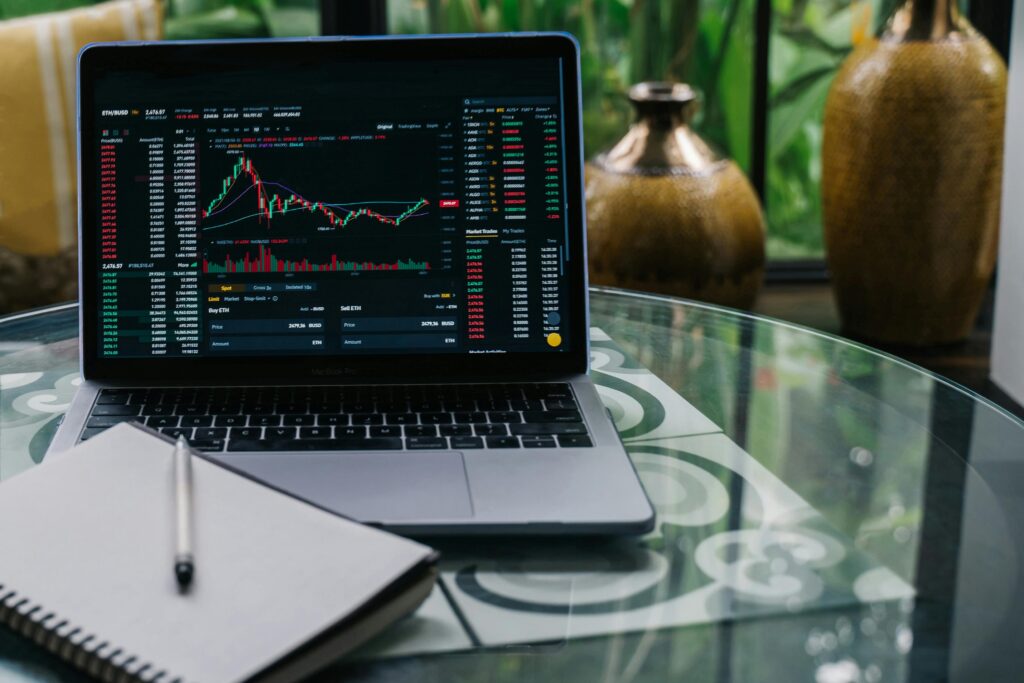Learn how to scale your cryptocurrency exchange securely & globally. From liquidity to compliance, this full guide covers every step to success.
Introduction
Scaling a cryptocurrency exchange isn’t just about adding more users or listing more coins—it’s like building a skyscraper while people are already living inside. Every new floor (or feature) brings massive growth potential, but also exposes new risks, from cyberattacks to compliance pitfalls.
The global crypto market is evolving at lightning speed, opening doors to millions of potential traders across different countries and time zones. But with those opportunities come challenges: securing transactions against increasingly sophisticated threats, maintaining liquidity so trades execute smoothly, and navigating complex international regulations.
That’s where this guide comes in. Whether you’re running a promising startup exchange or looking to take your existing platform global, we’ll walk through the essentials—technology upgrades, liquidity strategies, airtight security, compliance best practices, and sustainable growth tactics. Think of it as your blueprint for scaling confidently, securely, and successfully in the fast-paced world of crypto trading.
1. Understanding the Importance of Scaling
In the crypto world, speed and reliability aren’t just nice-to-have—they’re survival tools. Scaling a cryptocurrency exchange means making sure your platform can handle growing numbers of trades, users, and market activity without breaking a sweat. When things run smoothly, traders trust you. When they don’t… well, users have plenty of other platforms to jump to.
The risks of not scaling are very real. Imagine a sudden spike in trading volume—maybe Bitcoin just hit a new all-time high—and your exchange starts lagging or freezing. Orders fail, withdrawals take ages, liquidity dries up. Frustrated users leave, and once trust is gone in this space, it’s nearly impossible to win it back.
On the flip side, scalability isn’t just about avoiding disasters—it’s a direct driver of long-term profitability. A well-scaled exchange can process more trades, attract bigger investors, list more assets, and expand globally without sacrificing performance or security. In other words, scalability is the bridge between being a small local exchange and becoming a competitive player on the global stage.
Think of it this way: if your exchange is the engine, scalability is the fuel efficiency. The better it runs, the further you can go without burning out your resources.
2. The Crypto Exchange Landscape
Before you think about scaling, it’s worth taking a good look at the playing field you’re stepping into. Right now, the crypto exchange market is a fascinating mix of centralized exchanges (CEXs) and decentralized exchanges (DEXs), each with their own strengths, weaknesses, and fanbases.
Centralized exchanges like Binance, Coinbase, and Kraken dominate in terms of volume and user base. They offer slick interfaces, faster transactions, and customer support—things traders appreciate when they need speed and convenience. On the other hand, decentralized exchanges such as Uniswap, PancakeSwap, and dYdX are gaining serious traction thanks to their focus on privacy, self-custody, and freedom from traditional gatekeepers.
The competition is fierce. New players are popping up with unique selling points—whether that’s ultra-low fees, region-specific offerings, NFT integrations, or gamified trading experiences. But here’s the truth: you don’t need to beat everyone at everything. What you do need is a clear niche.
Finding your niche before scaling is like choosing the right gear before climbing a mountain. Maybe your edge is hyper-localized service for a specific region, a unique trading product, or unbeatable security features. Once you know exactly what sets you apart, scaling becomes more than just “getting bigger”—it becomes getting bigger in the right direction.
3. Laying the Groundwork for Scaling
Before you start dreaming about millions of users and global reach, you need a strong foundation. Scaling a crypto exchange isn’t just about adding more servers—it’s about building a system, a strategy, and a team that can grow without cracking under pressure.
It all starts with choosing a scalable business model. Your technology stack, liquidity setup, and revenue streams should be able to handle ten times the traffic without a full rebuild. That means thinking ahead: modular infrastructure, cloud-based hosting, and flexible API integrations so you can expand features without reinventing the wheel.
Next, be smart about setting realistic growth targets. It’s easy to get caught up in “we want to be the next Binance” hype, but reckless growth can sink a promising exchange. Instead, break your expansion into clear, measurable steps—like reaching a specific daily trading volume, entering a new regional market, or rolling out a defined number of trading pairs. These milestones keep you focused and make progress easier to track.
Finally, assemble your core team—the people who’ll turn your scaling plans into reality. You’ll need talented developersto keep the platform fast and secure, compliance officers to stay ahead of shifting regulations, and marketers who can attract and retain the right kind of users. In crypto, the team isn’t just a support system—they’re your competitive edge.
Get this groundwork right, and scaling becomes less of a gamble and more of a calculated climb toward long-term success.
4. Implementing Robust Security Protocols
In crypto, security isn’t a feature—it’s the foundation. As your exchange scales, the size of the target on your back grows too. Hackers follow the money, and the more trades you process, the more appealing you become to cybercriminals. That’s why your security measures must evolve in lockstep with your user base and transaction volume.
A few non-negotiable best practices every scaling exchange should have:
-
Cold & hot wallet separation – Keep the majority of funds in offline cold storage, far from internet access, and only use hot wallets for active trading liquidity. This limits the damage if a breach ever occurs.
-
Multi-signature authentication – Require multiple approvals before any large withdrawal or system change can be made. This isn’t just about technology—it’s about adding a human layer of protection against both internal and external threats.
-
Real-time fraud monitoring – Implement systems that can instantly flag suspicious activity, such as unusual withdrawal patterns or login attempts from high-risk locations. Early detection is your best chance to stop an attack before it escalates.
The truth is, one major security incident can erase years of hard work and trust. By treating security as a continuous, evolving process—not a one-time setup—you’re not just protecting funds; you’re safeguarding your exchange’s reputation and future.
5. Building Initial Liquidity
Liquidity is the lifeblood of any cryptocurrency exchange. Without enough buyers and sellers actively trading, your platform can quickly feel like a ghost town—orders get stuck, prices swing wildly, and traders lose confidence. Simply put, liquidity attracts more traders, and more traders bring even greater liquidity. It’s a positive cycle you want to kickstart early on.
So, how do you build that initial liquidity? One popular strategy is working with market makers—specialized traders or firms who commit to providing buy and sell orders, keeping your order book active and balanced. Partnering with liquidity providers and forming strategic partnerships with other exchanges or DeFi platforms can also inject much-needed depth into your markets.
Avoiding price slippage and thin order books is key here. Slippage happens when a trader’s order moves the market price because there isn’t enough volume to absorb it smoothly. This can be frustrating for users and hurt your exchange’s reputation. Ensuring a steady flow of orders and sufficient volume in each trading pair helps keep prices stable and the user experience seamless.
Building liquidity isn’t an overnight task—it takes planning, relationships, and continuous management. But get it right, and you’ll create a vibrant marketplace that keeps traders coming back.
6. Infrastructure and Technology Stack
When it comes to scaling a cryptocurrency exchange, your technology stack isn’t just a background detail—it’s the engine that powers every trade, every order, and every user interaction. Choosing the right infrastructure can make the difference between lightning-fast execution and frustrating delays that send users packing.
Many exchanges today lean toward cloud hosting because of its flexibility, scalability, and cost-effectiveness. Cloud platforms like AWS, Google Cloud, or Azure let you quickly add resources during traffic spikes and scale down when demand dips. On the other hand, some exchanges prefer on-premise setups for greater control and security, but this approach requires more upfront investment and maintenance. The right choice depends on your team’s expertise, budget, and security priorities.
A critical piece of the puzzle is your matching engine—the core system that pairs buy and sell orders. Optimizing matching engine performance is crucial to handle high volumes with minimal latency. Techniques like multi-threading, in-memory databases, and efficient order book data structures help ensure your platform can process thousands of transactions per second without breaking a sweat.
Remember, building a scalable tech stack isn’t about throwing the latest gadgets at the problem. It’s about designing a system that grows smoothly with your user base, stays reliable under pressure, and keeps your users happy every time they click “trade.”
7. API Scalability
In today’s crypto ecosystem, your exchange’s APIs are like the open doors that let trading bots, partners, and third-party apps seamlessly connect and interact with your platform. If your APIs aren’t designed to scale, those doors risk becoming bottlenecks, slowing down performance and frustrating users who rely on real-time data and quick order execution.
Scalable APIs handle growing traffic gracefully. This means implementing smart rate limits—not so strict that they block genuine users, but tight enough to prevent abuse and server overload. Reliability is another must-have. Downtime or delayed responses can cause missed trades or inaccurate pricing, which damages trust and user satisfaction.
Security can’t be an afterthought either. Every API request is a potential entry point for attacks, so protecting endpoints with strong authentication, encrypted communication, and continuous monitoring is key. The best exchanges build their APIs with scalability and security baked in from day one—so they’re ready to support rapid growth without compromising performance or safety.
Think of your API as a busy highway. With the right design, it can handle rush hour traffic without gridlock, keeping your entire exchange ecosystem running smoothly and efficiently.
8. User Acquisition and Retention Strategies
Growing your exchange isn’t just about technology and liquidity—it’s also about getting the right users on board and keeping them coming back. In today’s crowded crypto market, smart digital marketing and influencer partnerships can be game-changers. Influencers have loyal audiences that trust their recommendations, making them perfect allies to introduce your exchange to new communities.
But attracting users is only half the battle. To keep them engaged, consider adding gamification elements—like trading challenges, leaderboards, or rewards for hitting certain milestones. Referral programs are another powerful tool; people love sharing something valuable with their friends, especially when there’s an incentive for both sides.
Above all, building trust through transparency is crucial. Clear communication about fees, security measures, and how you handle user data builds confidence. Regular updates and open channels for feedback make users feel heard and valued. After all, in crypto, trust is the currency that keeps users loyal over the long haul.
Combining these strategies helps create not just a platform, but a community—one that grows naturally and stands strong through market ups and downs.
9. Localization and Global Expansion
Going global is an exciting milestone for any crypto exchange, but it’s not as simple as flipping a switch. Localization—adapting your platform and approach to fit different regions—is absolutely key to winning users around the world.
Start with multi-language interfaces. Traders feel more comfortable and confident when they can navigate your exchange in their native language. Beyond language, integrating local fiat currencies for deposits and withdrawals removes friction and broadens your appeal to users who prefer familiar payment options.
But localization goes deeper than tech—it’s about understanding and respecting cultural differences. Tailoring your marketing messages and customer support to match local customs and preferences shows users you’re not just another global platform, but one that truly cares about their unique needs.
The journey to global expansion can be complex, but with thoughtful localization, you’ll build bridges that connect your exchange to diverse markets—unlocking growth opportunities and creating a truly worldwide crypto community.
10. Navigating Regulatory Compliance
One of the trickiest parts of scaling a cryptocurrency exchange is staying on the right side of the law—especially when you’re going global. Different countries have their own rules, and those rules can change fast. Understanding the regulatory landscape in each market you enter isn’t just a checkbox; it’s essential for keeping your exchange running smoothly and building trust with users and partners.
At the heart of compliance are KYC (Know Your Customer) and AML (Anti-Money Laundering) processes. As your user base grows, these safeguards help prevent fraud, money laundering, and other illegal activities. They might seem like hurdles, but they actually protect your business and reputation in the long run.
Working closely with legal advisors who specialize in crypto regulations is a smart move. They can guide you through licensing requirements, reporting obligations, and any updates to legislation—helping you avoid costly missteps. Remember, compliance isn’t just about following rules; it’s about building a foundation for sustainable, global growth.
11. Scaling Liquidity
Once your exchange has built a healthy base of initial liquidity, the next step is scaling it to keep up with growing demand. Liquidity isn’t just about volume—it’s about depth, stability, and the ability to handle large trades without distorting market prices.
One approach is expanding your liquidity pools, either by partnering with more market makers or by creating incentives for high-volume traders to keep their capital active on your platform. This ensures your order books stay thick and your spreads remain competitive.
Another powerful tactic is integrating with global liquidity networks. By connecting to shared liquidity hubs or aggregators, your exchange can tap into order flow from multiple sources—instantly boosting trading activity and improving execution speeds for your users.
Finally, explore cross-exchange arbitrage opportunities. By strategically linking your platform with other exchanges, you can take advantage of price differences to balance liquidity across markets. This not only smooths out volatility but can also generate additional revenue streams.
Scaling liquidity is a continuous process, but done right, it transforms your exchange into a vibrant, high-volume marketplace that traders trust and rely on—day in and day out.
12. Enhancing Customer Support and Community
In the fast-paced world of crypto trading, problems can happen at any hour—and traders expect solutions just as quickly. That’s why 24/7 multilingual support is no longer a luxury; it’s a necessity. Whether it’s a withdrawal delay at 3 AM or a KYC verification issue on a weekend, having responsive, round-the-clock assistance builds trust and keeps frustration from boiling over.
Beyond direct support, building active communities on platforms like Telegram and Discord can be a game-changer. These spaces give traders a place to connect, share insights, and get quick answers—sometimes even from other community members before your team steps in. An engaged community not only strengthens loyalty but also serves as a valuable source of feedback for improving your platform.
Education is another key piece. Providing guides, FAQs, and video tutorials empowers users to solve common issues themselves, which reduces support load and speeds up problem resolution. It’s a win-win—users feel more confident, and your support team can focus on the more complex cases.
A strong support system and an active community don’t just solve problems—they create a sense of belonging. And in an industry where trust and connection are everything, that’s an advantage no marketing campaign can match.
13. Strengthening Security (Advanced Stage)
Once your exchange is up and running at scale, basic security protocols aren’t enough—you’ll need to go deeper to stay ahead of evolving threats. This is where advanced security practices come into play, ensuring your platform remains resilient even under constant pressure from hackers, fraudsters, and internal risks.
Regular penetration testing and security audits are essential. These “ethical hacking” exercises simulate real-world attacks to expose vulnerabilities before bad actors can exploit them. Pair this with independent audits to verify code integrity, infrastructure resilience, and compliance readiness.
Another powerful tool is a bug bounty program. By incentivizing ethical hackers to find and report security flaws, you tap into a global network of cybersecurity talent. It’s a proactive way to discover weaknesses that might otherwise go unnoticed.
Finally, don’t overlook insider threat prevention. Not all risks come from outside—disgruntled employees, contractors, or even accidental mishandling of sensitive data can cause significant damage. Implement strict access controls, monitor unusual activity, and maintain a strong culture of accountability to minimize these risks.
At the advanced stage, security isn’t a one-off project—it’s an ongoing mission. The exchanges that survive and thrive are the ones that treat it as a living, breathing part of their growth strategy.
14. Forming Strategic Partnerships
In the competitive crypto exchange space, you don’t have to go it alone. The right strategic partnerships can accelerate growth, boost credibility, and open doors to opportunities that would be tough to achieve on your own.
Start with payment processors and blockchain networks. Integrating with trusted payment gateways makes deposits and withdrawals seamless, while connecting to multiple blockchain ecosystems expands the range of assets you can list and trade. These integrations not only improve the user experience but also position your exchange as a versatile, future-ready platform.
Influencer collaborations can also work wonders for brand visibility. Partnering with credible voices in the crypto space helps you tap into their established audiences, giving your exchange an instant trust boost—especially in new markets where you’re still building recognition.
On a larger scale, institutional partnerships—with market makers, liquidity providers, or even traditional financial institutions—can inject deep liquidity and strengthen your platform’s reputation. When traders see well-known industry players backing your exchange, it signals reliability and stability.
In short, strategic partnerships aren’t just about connections—they’re about multiplying your strengths and reaching your scaling goals faster, together.
Conclusion
Scaling a cryptocurrency exchange is a journey, not a sprint. We’ve walked through the essentials—from laying a solid foundation and choosing the right tech stack, to building liquidity, navigating regulations, enhancing security, and forming partnerships that amplify your reach. Each step matters, and each one builds on the last.
The most successful exchanges share three core strengths: rock-solid security, deep and reliable liquidity, and unshakable regulatory compliance. Get these right, and you’re not just growing bigger—you’re building a platform that traders can trust for the long haul.
At the end of the day, scaling isn’t about chasing hype; it’s about creating sustainable growth that can weather market ups and downs. Focus on protecting your users, keeping your markets active, and staying ahead of legal requirements, and you’ll have a competitive edge that lasts.
Your exchange’s global future is wide open—now it’s time to scale it, securely and smartly.
FAQs – Scaling & Building Cryptocurrency Exchanges
1. How to scale your crypto?
Scaling your crypto exchange involves improving your platform’s infrastructure, security, and liquidity so it can handle more users, higher trading volumes, and global operations without downtime or slow performance. Key steps include:
-
Upgrading your technology stack and servers.
-
Partnering with liquidity providers to avoid thin order books.
-
Implementing advanced security like multi-signature wallets and DDoS protection.
-
Expanding into new markets through localization and regulatory compliance.
-
Offering strong customer support to retain users.
2. What is scaling in crypto trading?
Scaling in crypto trading refers to increasing a platform’s ability to process more transactions, handle more traders, and support a wider range of assets without sacrificing speed or security. For traders, it can also mean using a “scaling in” or “scaling out” strategy—buying or selling in portions instead of all at once—to manage risk. For exchanges, scaling focuses on infrastructure, liquidity, and regulatory readiness.
3. How to choose the best cryptocurrency exchange?
When choosing a cryptocurrency exchange, consider:
-
Security: Look for 2FA, cold storage, and audit reports.
-
Liquidity: High trading volumes mean faster order execution and better prices.
-
Regulation: Make sure the exchange is licensed in your jurisdiction.
-
Fees: Compare trading, deposit, and withdrawal charges.
-
User Experience: A smooth, reliable interface with mobile access is a plus.
-
Customer Support: Fast, responsive support channels are essential.
4. How to build your own crypto exchange?
Building your own cryptocurrency exchange involves:
-
Research & Planning: Decide between a centralized or decentralized model.
-
Licensing & Compliance: Register your business and follow KYC/AML laws.
-
Technology Development: Build or buy a trading engine, wallet integration, and user interface.
-
Liquidity Setup: Partner with market makers or integrate with existing liquidity pools.
-
Security Implementation: Use multi-signature wallets, encryption, and DDoS protection.
-
Launch & Marketing: Test thoroughly, launch, and attract users through marketing campaigns.














Pingback: Low Interest Credit Cards: Your Ultimate Guide to Zero and 0% APR Offers
Pingback: How to Invest in Cryptocurrency and Make Money: A Complete Beginner’s Guide - JobyNest